http://www.gsmarena.com/week_37_in_review_iphone_6_iphone_6_plus_watch_galaxy_note_4-news-9624.php
he Week In Review is our series meant to recap all the major announcements of the week, which you might have missed. Week 37 was all about Apple's big announcement event where the iPhone 6, iPhone 6 Plus and Watch went official.Additionally, Microsoft is rumored to drop the Nokia and Windows Phone branding altogether, while the Galaxy Note 4 went on pre-order costing an arm and a leg. Qualcomm also made the headlines with its new quad-core Snapdragon 210 entry-level chipset.
he Week In Review is our series meant to recap all the major announcements of the week, which you might have missed. Week 37 was all about Apple's big announcement event where the iPhone 6, iPhone 6 Plus and Watch went official.
Apple officially announces the iPhone 6 Plus with a 5.5" display
olution (1920 x 1080 pixels or, in other words 1080p). The pixel density is 400 ppi and iOS 8 has been tweaked to take full advantage of the larger display.The back of the iPhone 6 Plus is made of anodized aluminum and the stainless steel frame of the phone ensures its rigidity.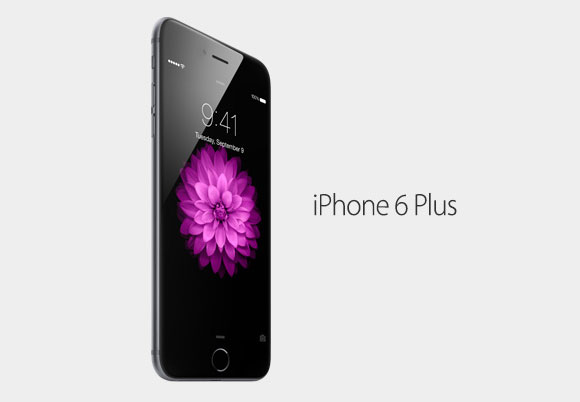
The user interface has been optimized to take advantage of the larger screen and offers split-screen mode in several apps like earlierleaks suggested.The new 64-bit A8 chip that powers the Apple iPhone 6 Plus is built using the 20nm manufacturing process. Thanks to this it's more power efficient, while still offering 25% more CPU power and 50% GPU boost.The iPhone 6 Plus supports 20 LTE bands, but only 150Mbps cat4 LTE, rather than the latest 300Mbps Cat 6. On the positive side the phablet comes with VoLTE and Wi-Fi 802.11ac, which promises 3x faster Wi-Fi compared to the iPhone 5s. Wi-Fi calling is also a new feature, which will work on T-Mobile in the US and EE in the UK.Further on, the iPhone 6 Plus packs NFC, another first for the company. Thanks to it, you'll be able to make payments by using Apple Pay - Apple's own NFC payment system.At the back, the iPhone 6 Plus uses a 8MP iSight camera with a True Tone dual LED flash. The pixel size is the same as on the iPhone 5s at 1.5μ and the aperture is unchanged at f/2.2. However the iPhone 6 Plus has an optical image stabilization - a first for the company.There's also phase-detection autofocus that should improve focusing speed twice. It is enabled by the A8 chip, which also includes powerful image signal processor designed by Apple.The Apple iPhone 6 Plus camera records 1080p video at 30 and 60fps. There's a slow-mo shooting available, too, at 240fps, but its resolution hasn't been specified.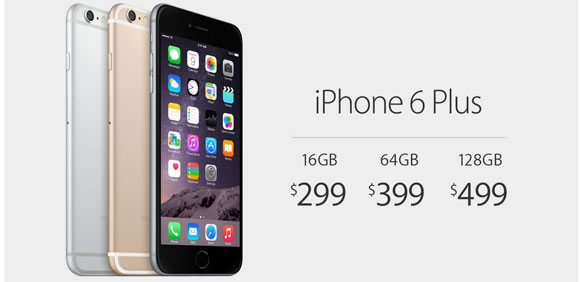
The Apple iPhone 6 Plus will start at $299 for the 16GB version, while the 64GB and 128GB will retail for $399 and $499, respectively.iPhone 6 Plus pre-orders commence on September 12 and shipments being a week later, on September 19.
Apple unveils the 4.7-inch iPhone 6 with Retina HD screen
Tim Cook took the stage at the start of today's event and almost immediately announced the new iPhone 6. The Apple iPhone 6 is based on iPod touch looks and has a 4.7" screen.The screen is protected by "Ion-strengthened glass", which is curved around the edges for a more seamless experience when swiping. The screen itself is an LCD with "Retina HD," which translates to 750 x 1,334 pixels. This pushes the pixel density to 326ppi.


Apple iPhone 6Despite the new resolution, apps will "just work" thanks to a desktop-class scaler. This will only be needed until devs update their apps to support the new resolution.The 8MP iSight camera is back for a fourth year in a row. Apple claims the camera has been improved now - it still has 1.5µ pixels, but features phase detection autofocus and sits behind an f/2.2 aperture. There's no OIS though, it relies on digital stabilization. The camera can shoot panoramas up to 43MP.The video resolution is kept at 1080p but the 60fps has now been promoted to the max FullHD resolution (up from 720p @ 60fps). Slo-mo video can shoot at 120fps and 240fps, but at a lower resolution.The chassis is made of anodized aluminum with a stainless steel Apple logo. The body is just 6.9mm thick.The Apple iPhone 6 is powered by a second-generation chipset, the Apple A8. It offers 25% more CPU power and 50% extra GPU oomph. The chipset is built on a power-efficient 20nm process, which also makes it 13% smaller physically than its A7 predecessor.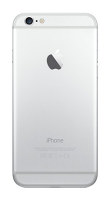
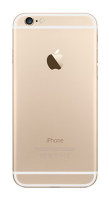
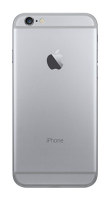
Three color options: Silver, Space Grey and GoldApple promises the battery life for the new iPhone 6 will be equal or better than the 5s. It will do up to 14 hours of talk time. Aside from the regular GSM calling, it supports VoLTE (Voice Over LTE) and Wi-Fi calling (for T-Mobile in teh US and EE in the UK). LTE has been updated to support up to 150Mbps downlink (Cat. 4) and supports up to 20 bands.Other connectivity upgrades include Wi-Fi 802.11ac for three times faster Wi-Fi speeds. Finally, there's also NFC now, which enables Apple's new Apple Pay service for wireless payments.The M8 co-processor succeeds the M7 and is coupled with a barometer. The two accurately track changes in elevation and can even count the steps you've taken.
The Apple iPhone 6 will cost $199 for the base 16GB model (with two-year contract). There's no 32GB model this year, $299 buys you 64GB instead and there's a $399 128GB version. Pre-orders start on September 12, the phones will ship on the 19th.



Apple iPhone 6



Three color options: Silver, Space Grey and Gold
Apple Watch - square sapphire display, gold option
One more thing! The Apple Watch is real – with a square screen and comes in 38mm and 42mm cases. There will be an 18 karat gold version but more affordable stainless steel and aluminum versions will be available too. The steel version will be called Watch Sport, the gold one will be Watch Edition.All will have changeable wristbands, ceramic backs and sapphire screens. Six different bands will be available at launch.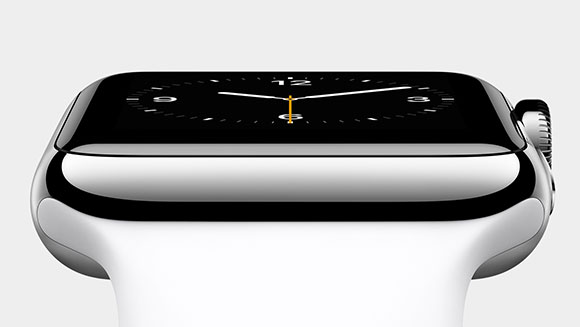
The screen will not be always-on, it activates when you lift your wrist. The Glances feature lets you can swipe through pages of information on the touchscreen (hello, Android Wear).The touch-screen is force-sensitive and you can add custom gestures (with swipes and presses).


Apple WatchAlternatively, you can use the digital crown to interact with the watch, including zooming in on the maps application.Siri will of course work with the Apple Watch. The watch won't have you typing in answers, it will recognize questions from incoming messages and offer appropriate responses. Or you could use Siri for voice dictation.Yet another way to communicate is with emoji or quick sketches on the touchscreen.


Apple WatchThe watch can monitor your heart rate but relies on the iPhone for GPS positioning (for when you go on a run).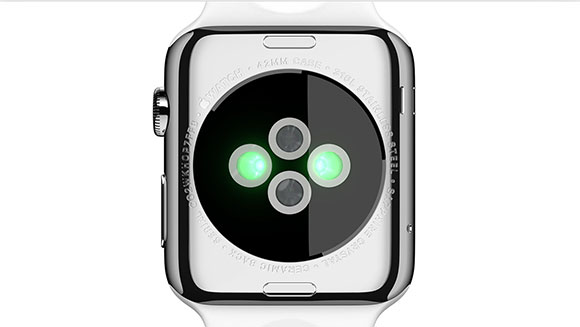 Similar to Android Wear, notifications from your iOS device will just show up on the phone. The upcoming WatchKit will allow developers to create custom apps for the watch too.A potential killer feature is that it will work with Apple Pay.The Apple Watch will be charged with a Magsafe wireless adapter. A magnet will guide the charger to just the right place.The Watch will cost $350 and will be available only in early 2015. iPhone 4S and below owners need not apply.
Similar to Android Wear, notifications from your iOS device will just show up on the phone. The upcoming WatchKit will allow developers to create custom apps for the watch too.A potential killer feature is that it will work with Apple Pay.The Apple Watch will be charged with a Magsafe wireless adapter. A magnet will guide the charger to just the right place.The Watch will cost $350 and will be available only in early 2015. iPhone 4S and below owners need not apply.



Apple Watch



Apple Watch

Micromax launches Canvas Nitro A310 in India
Micromax has launched the new Canvas Nitro A310 in India in partnership with Snapdeal.

The Canvas Nitro has a 5.0-inch, 1280x720 IPS LCD, MediaTek MT6595 SoC with octa-core 1.7GHz CPU and Mali 450 MP GPU, 2GB RAM, 8GB storage space with microSD card slot, 13 megapixel rear camera, 5 megapixel front camera, 2,500mAh battery, dual SIM support, and Android 4.4 KitKat.
The Canvas Nitro will be available exclusively through Snapdeal for ₹12,990 starting September 8.
Nokia brand gone soon, the "Phone" in Windows Phone too
The software giant has so far continued to use the Nokia name for phones, most recently with the Lumia 830 and Lumia 730 that were officially unveiled last week. However, a new rumor claims these two will be the last handsets to come with the Nokia brand on them.
As the image above shows (which is purportedly part of a leaked internal document from Microsoft), starting with this year's "Holiday campaign" the Nokia brand will be gone from Microsoft Mobile's devices. The same won't happen with the Lumia brand, which will live on.Interestingly, back in July a Lumia 830 render was leaked sporting "Nokia by Microsoft" branding on the back, but the actual smartphone is just called Nokia. Perhaps this was to be a transition strategy that Microsoft subsequently dropped for whatever reason. So expect the next phones to come out of Microsoft Mobile to be called either just Lumia something, or Microsoft Lumia.The company also has similar plans for the Windows Phone name. In this case, though, there will be a more gradual transition, during which the "Phone" in Windows Phone will fade away - until eventually it won't be there anymore. So Microsoft's mobile OS will be called Windows, just like its desktop OS. Since the two still aren't the same thing, this could of course confuse many people.Microsoft is slowly integrating Windows Phone with desktop Windows (or so it's been saying for a few years now), so at some point the unified brand will make sense. Hopefully the timing will be right, as apparently there will be no "Windows Phone 9" release. It will exist, of course, but sans "Phone" in its name, as you might have guessed
Samsung Galaxy Note 4 and Note Edge German pre-orders launch
Want to be among the first to get the Samsung Galaxy Note 4 or Note Edge? If yes we have news for - good news and bad news.
The cool part is that several German retailers have already launched their pre-order campaign, so you can book your unit right now and never worry there won't be stock left for you. The not-really-cool bit is that some of them have added such a hefty premium on top of the expected asking price that it makes you wonder if it's worth it.

Pre-orders are taken at the mind-blowing €995.91 - almost $1,300. Amazon DE even has the guts to say that you are actually saving just over €3 from the regular retail price, which according to it will stand at €999. Even though Samsung has failed to quote a specific price, we can bet that this is far from the truth.
Things are looking far more reasonable over at Notebooksbilliger, redcoon and MediaMarkt, which all charge €699 to book your Galaxy Note 4. The first of those stores also lists the Galaxy Note Edge on pre-order, but it comes with another €1,000 price tag.
Given that last year Samsung launched the Galaxy Note 3 last year at about €600, we imagine its successor won't start much higher now. Even if Samsung goes for a price hike, it's extremely unlikely that it will be more than €50 - it's just how things work in this business.
It's likely that the Galaxy Note Edge will warrant a higher price, given that its the first device of its kind. It's anyone's guess how high Samsung might go there really.
Snapdragon 210 with quad-core CPU and LTE goes official
Today Qualcomm announced its next generation affordable chipset - Snapdragon 210. Its key upgrades over the existing Snapdragon 200 include better Adreno 304 GPU, 1080p video capture and playback support, and LTE Cat.4 connectivity.

These are the new Snapdragon 210 key specifications:
- Quad-core ARM Cortex-A7 processor up to 1.1 GHz
- Adreno 304 GPU with support of 720p displays
- 8MP camera support
- 1080p video recording and playback
- LTE Cat.4 connectivity
- LTE dual-SIM support
- Quick Charge 2.0 support (up to 75% faster charging)
Qualcomm expects the new entry-level Snapdragon 210 chipset to become available in various affordable smartphones in the first half of 2015. The manufacturer hopes its latest design will enable the creation of the first LTE-A sub-$100 smartphones.



No comments:
Post a Comment